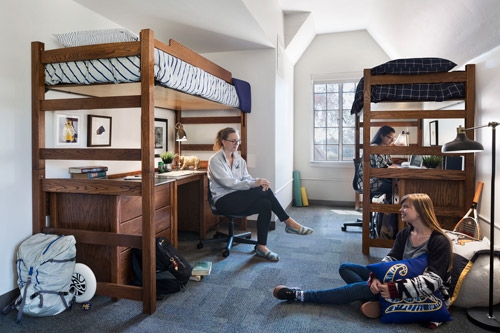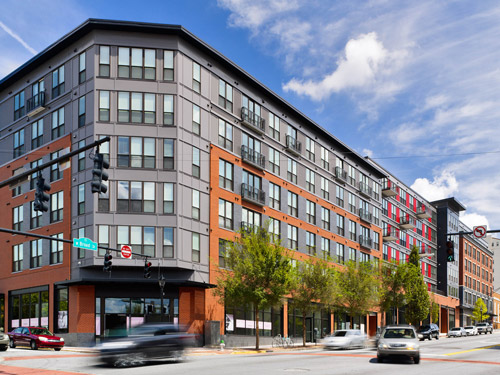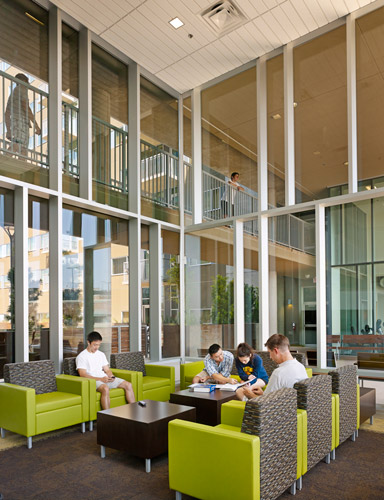EdR and its CEO Randy Churchey play a key role in remaking the student housing business.
Gone are the days when going away to college meant sharing a communal bathroom in a boxy, brick tower. Today’s student housing – the preferred term over “dorms” – is far different: It includes a variety of formats and layouts tailored to today’s students, who have ample variety for new and updated housing both on and off campus.
An architect of this revolution is Randy Churchey, who took the helm as president and chief executive officer of EdR (NYSE: EDR) in January 2010. Recognizing the sector’s untapped potential, the Memphis-based company has worked closely with schools that want to replace outdated housing, but often face deep budget cuts and a desire to invest in academics.
The company now owns or manages more than 80 communities with upwards of 43,000 beds serving more than 50 universities in 25 states. From January 2010 until December 2016, EdR’s total shareholder return came in at 275 percent, according to financial filings, putting it in the REIT elite.
Churchey, who in 2015 added chairman of the board to his title at EdR, talked with REIT about the evolution of the sector and what today’s parents and students want from student housing. He also broke out his crystal ball to predict the future of the sector.
REIT: Tell me about your own housing situation as an undergrad.
Churchey: I lived in an on-campus fraternity house for three-and-a-half of my four years while at the University of Alabama. While the fraternity house was nice for its time, I was sharing a small room with a roommate, and there was a central shower/bathroom down the hall for everyone on the floor.
REIT: How have upgraded housing options changed your business?
Churchey: The modernization of housing has been the primary driver of external growth for our business.
 Students’ tastes and needs for housing, as well as parents’ expectations, have evolved over the years. For previous generations of students, growing up sharing a bedroom with a sibling was common, so living in close quarters with a roommate didn’t feel foreign. Students today are raised with their own bedroom, bathroom and often a room devoted to their entertainment, so privacy is important. Modern on-campus accommodations reflect that change in culture.
Students’ tastes and needs for housing, as well as parents’ expectations, have evolved over the years. For previous generations of students, growing up sharing a bedroom with a sibling was common, so living in close quarters with a roommate didn’t feel foreign. Students today are raised with their own bedroom, bathroom and often a room devoted to their entertainment, so privacy is important. Modern on-campus accommodations reflect that change in culture.
For off-campus, purpose-built student housing, they want pedestrian-to-campus living, so they are close to everything the campus has to offer, but with some independence. Our 82 communities spanning 52 universities allow these conveniences for students.
Additionally, the wave of universities using public-private partnerships (known as “P3”) that began about 10 years ago has impacted our business significantly. Many universities determine the best way to revamp old and outdated housing is to engage a company in a P3 relationship to keep the project moving at a faster pace and also to use someone else’s financial resources.
In 2009, EdR was the first company to have an on-campus asset in a P3 environment, where we owned the asset, and that was at Syracuse University. The University of Texas, University of Kentucky and Cornell University have also opted to do a P3 development with us. These universities, some of which have very large endowments, are seeing the benefits of P3, and this model has been widely accepted by the university community.
REIT: What about the industry attracted you to student housing?
Churchey: I spent many years in the hotel business, and student housing is very similar in many ways. Both industries are grounded in hospitality and are all about pleasing our guests (and in our case, our students) every day.
I joined EdR in 2010 and was fascinated by the possibilities to modernize both on- and off-campus housing. This still excites me today. We’ve barely scratched the surface of student housing’s potential.
REIT: Student housing is a bit like apartments, but you’re dealing with people who are still being shaped as adults. How does that affect your operations? Does it affect how you try to manage and cultivate EdR’s workforce?
Churchey: It is definitely a different viewpoint, and college is such a critical point in a young person’s life. That’s why we have community assistants (CAs) at our communities and programs to ensure our residents have a community of which to be a part. Our operations team trains our CAs on a variety of things to ensure our residents feel right at home and adjust to their independence. We operate our communities with the needs of college students in mind.
 From social functions and resident engagement to health and wellness initiatives, we care about our residents and want to ensure their time living with us is memorable. And we don’t just focus on the social aspect of being away at college. We strive to improve the well-being of our residents by creating a healthy living environment and promoting healthy habits that will impact them throughout their entire life. Through our “Live Here. Live Well.” program, our communities promote nutrition, fitness and mental strength, and offer opportunities to give back to the greater community.
From social functions and resident engagement to health and wellness initiatives, we care about our residents and want to ensure their time living with us is memorable. And we don’t just focus on the social aspect of being away at college. We strive to improve the well-being of our residents by creating a healthy living environment and promoting healthy habits that will impact them throughout their entire life. Through our “Live Here. Live Well.” program, our communities promote nutrition, fitness and mental strength, and offer opportunities to give back to the greater community.
REIT: Your residents know they aren’t sticking around.
Do they still cause a lot of wear and tear on housing? How do you handle maintenance and refurbishment costs when everyone moves in and out at the same time?
Churchey: Our residents actually tend to take pretty good care of our buildings and their units. Of course, it probably helps that we have many security cameras in the common areas and parental guarantees for damages.
The most intensive time period in student housing is the annual move-out and move-in of students, or as we call it, “turn.” In a short two-week time frame, we have to restore each and every apartment to move-in acceptable condition. This turn period has just started at some of our communities and will continue for most of the month of August, depending on the respective university’s class start dates.
Our people – both on-property employees and home office employees alike – gear up for this a few months ahead of time and relish the huge challenge. It is a great team-building event that combines blood, sweat and tears with laughs and team bonding. It is all worth it when you see the excitement from our new residents, and in many instances their parents.
REIT: Student housing isn’t just on campus. How has social media and increased community activism changed how you work with surrounding communities? What kind of engagement do you have with local residents and officials in a place like Fort Collins, Colorado, or Columbia, Missouri?
Churchey: Social media has become the center of our resident engagement. We are way beyond taping notes on doors. Social media has become a primary avenue of communication and marketing. We are very involved with everyone from the university to the community and surrounding neighborhoods.
Our goal is to ensure we aren’t just a building in the neighborhood or community, but a permanent part of the university and its surrounding neighborhood.
REIT: The deal to update the University of Kentucky’s housing stock was a transformative moment in student housing that has shaped how other campuses are approaching the business. How is it going and what have you learned?
Churchey: In 2012, we were selected by the University of Kentucky to help them transform their campus by replacing all of their on-campus housing. We delivered new, state-of-the-art on-campus housing in 2013, 2014, 2015, 2016 and the final phase this year. In total, 6,850 beds.
The feedback from the thousands of students who have already lived in our housing has helped us constantly evolve and make the on-campus living experience better. For example, UK students loved our communal kitchens, so we added more of those spaces in later phases of the project.
The impact at the University of Kentucky has been substantial – enrollment increases ahead of their peers, higher incoming student academic achievements and higher student retention, to name a few. By this project being financed by our ONE Plan [see sidebar below], the university was able to modernize housing, while preserving debt capacity for academic purposes with no adverse impact on their credit rating.
 We currently own on-campus housing under the ONE Plan at Syracuse, University of Texas, Texas Christian University and Kentucky, and are currently developing at Cornell, Northern Michigan and Boise State. This method of financing new on-campus housing under the ONE Plan has achieved acceptance in higher education over the last few years, with more universities looking to the same model to update existing and outdated housing.
We currently own on-campus housing under the ONE Plan at Syracuse, University of Texas, Texas Christian University and Kentucky, and are currently developing at Cornell, Northern Michigan and Boise State. This method of financing new on-campus housing under the ONE Plan has achieved acceptance in higher education over the last few years, with more universities looking to the same model to update existing and outdated housing.
REIT: Get out your crystal ball: Do you expect to see more public companies joining the student-housing sector anytime soon?
Churchey: I expect to see some additional public student housing companies within the foreseeable future. Our business is maturing and is readily accepted by the public markets.
REIT: Keeping with that crystal ball, describe the student housing that today’s toddlers will someday live in. What will remain and what will change?
Churchey: The key for the future will be technology and flexibility. Today, strong, reliable Wi-Fi is as important as water to our residents. When today’s toddler goes to college in 18 years, that need for technology and constant connectivity will only increase.
Flexibility of the spaces, both public and private, will also be something that will always reign in our communities. Whether it is public spaces, where students can study, socialize or work on group projects together, or exercise spaces that can be a yoga or fitness studio or on-demand exercise, flexibility to adapt to the next big thing in student housing is a key component of an EdR community.
The One Solution
Educators know that higher-ed students want to live in modern space whilelearning in high-tech classrooms. The only problem is finding a way to pay for that in an era when budget cutting is routine.
Enter EdR’s ONE Plan, which takes care of the beds and frees up capital for schools to use at what they do best. Under the plan, EdR enters a ground lease — typically between 50 and 75 years — funds and develops or upgrades the housing, and then operates and maintains it. The schools get the benefit of income from a well-known REIT with minimal work. What’s more, EdR itself assumes equity and debt responsibility, so the closely watched debt capacities of the schools are unaffected.
“The ONE Plan is a financing option that allows universities to update and modernize their housing stock while still preserving their capital for other projects on campus,” says EdR President Tom Trubiana. “The ONE Plan aligns the interests of the university and our company, while offering the university a single trusted partner for all steps of the development and management process.”
The list of ONE Plan communities includes Syracuse University, the University of Texas, the University of Connecticut and the University of Kentucky.